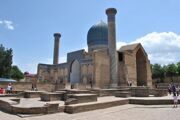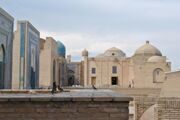 |
 |
 |
 |
| Marakanda to the Greeks. One of Central Asia's oldest settlements. The capital of Tamerlane's empire Mawaranahr. | |||
Ancient capital of fluted domes and sky blue mosaic, the Pearl of the East, emporium on major Silk Road crossroads and trade routes west to Persia, east to China and south to India - that’s the amazing and fascinating Samarkand. City of Famous Shadows reveals Samarkand as witness to the full sweep of Central Asia history, among conquerors to cast their shadows were the Macedonian Alexander the Great, the Mongol Genghis Khan. In 1370 Tamerlane achieved supremacy in Transoxiana, his choice of capital was obvious - Samarkand’s history, fertility and potential for rebirth. For next 35 years the lands of Persia, Syria, Asia Minor and India dispatched into Samarkand their minds: scholars, historians, theologians, architects, masons, painters, calligraphers, tile-glaziers, silk-weavers, glass-blowers, silversmiths and gunsmiths to create the Centre of Universe.
The Greeks called Samarkand "Marakanda" ("City on the river with vegetated banks"), which is quite probable, given that Samarkand was founded along the river Zarafshan with tug-stricken banks. "Marakanda" can also mean from the ancient Persian "fertile city" or "a city with a good climate, in which there is a lot of greenery and fruit."
Samarkand is located in the valley of the Zarafshan river at the foothills of the Pamir-Alai (Tien-Shan), this fabulous oasis still fascinates travelers. The city of "Famous Shadows" is a witness to the history of Central Asia, among the conquerors left their shadows were Alexander the Great, the Mongol Chingiz Khan.
In the city, still carefully guard the secrets of masters of applied art. It is chasing metal, carving on wood, embroidery in gold and silk, jewelry, carpet weaving, a magnificent mosaic decorating the walls of monumental buildings. Each of the products is a true work of art. The most famous museums of the world are proud to have in their collections exhibits created by the hands of Samarkand masters.
The center of the city of Samarkand is included in the list of world cultural heritage of UNESCO. Up to this day many buildings of Samarkand reached the time of Timur's reign, although some of them were reconstructed. Among them are the Registan ensemble, the Bibi-Khanum mosque, the Shakhi-Zinda memorial complex, and others. The great conqueror Timur is buried in the Gur-Emir mausoleum (1403-1404) in Samarkand. Among the remarkable monuments of Timurid architecture is also the Madrassah of Ulugbek. The subsequent history of Samarkand is also reflected in its architectural appearance. Medieval Khoja-Ahrara (17th century) has been preserved since the Bukhara Khanate. In 1868-1917, when Samarkand was part of the Russian Empire, the Khazret-Khizr Mosque was built (19th century). All buildings are distinguished by the richest architectural decoration: carved glazed terracotta, carved mosaic, majolica.
Useful links:
Samarkand Hotels
Samarkand Restaurants
Samarkand Workshops















